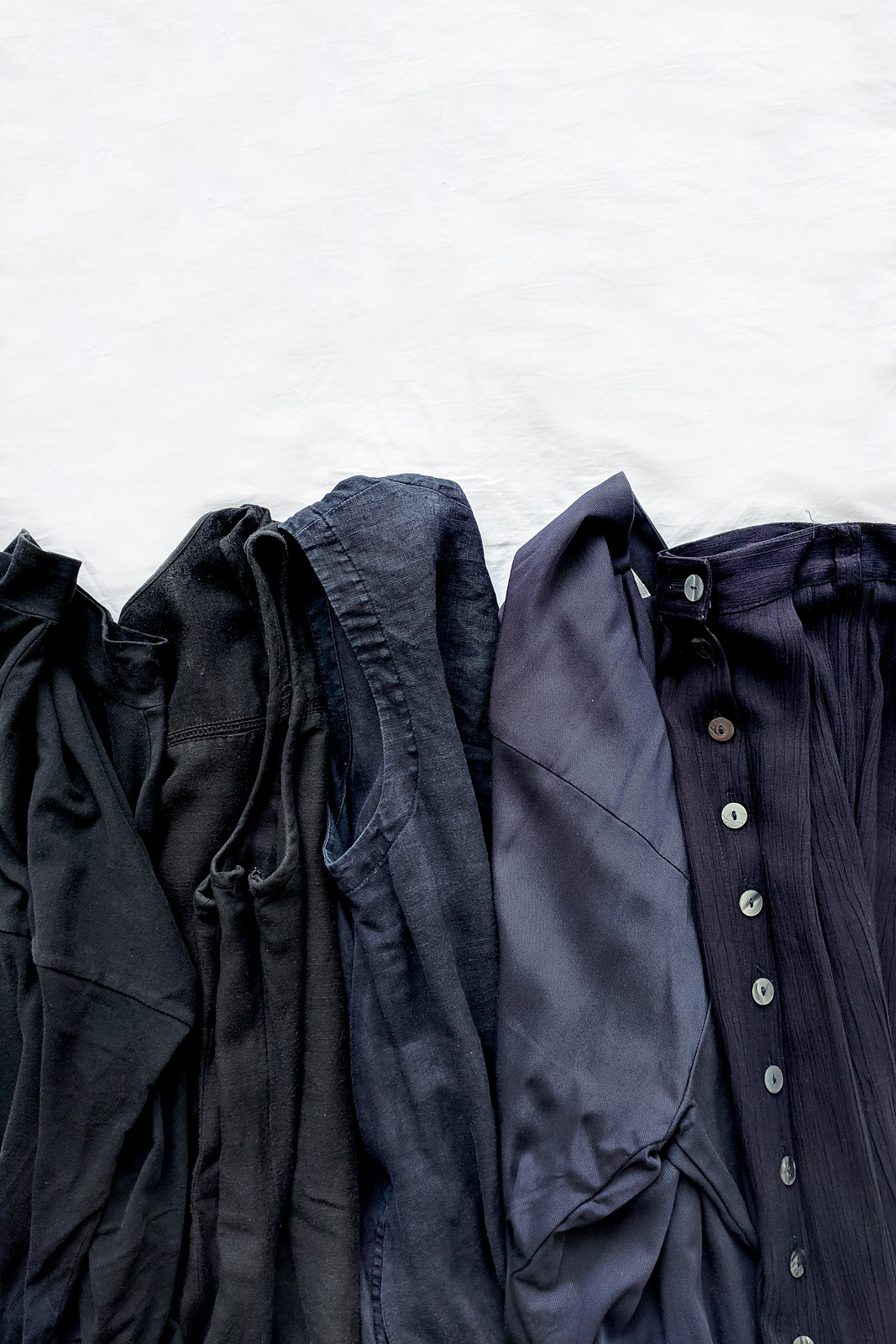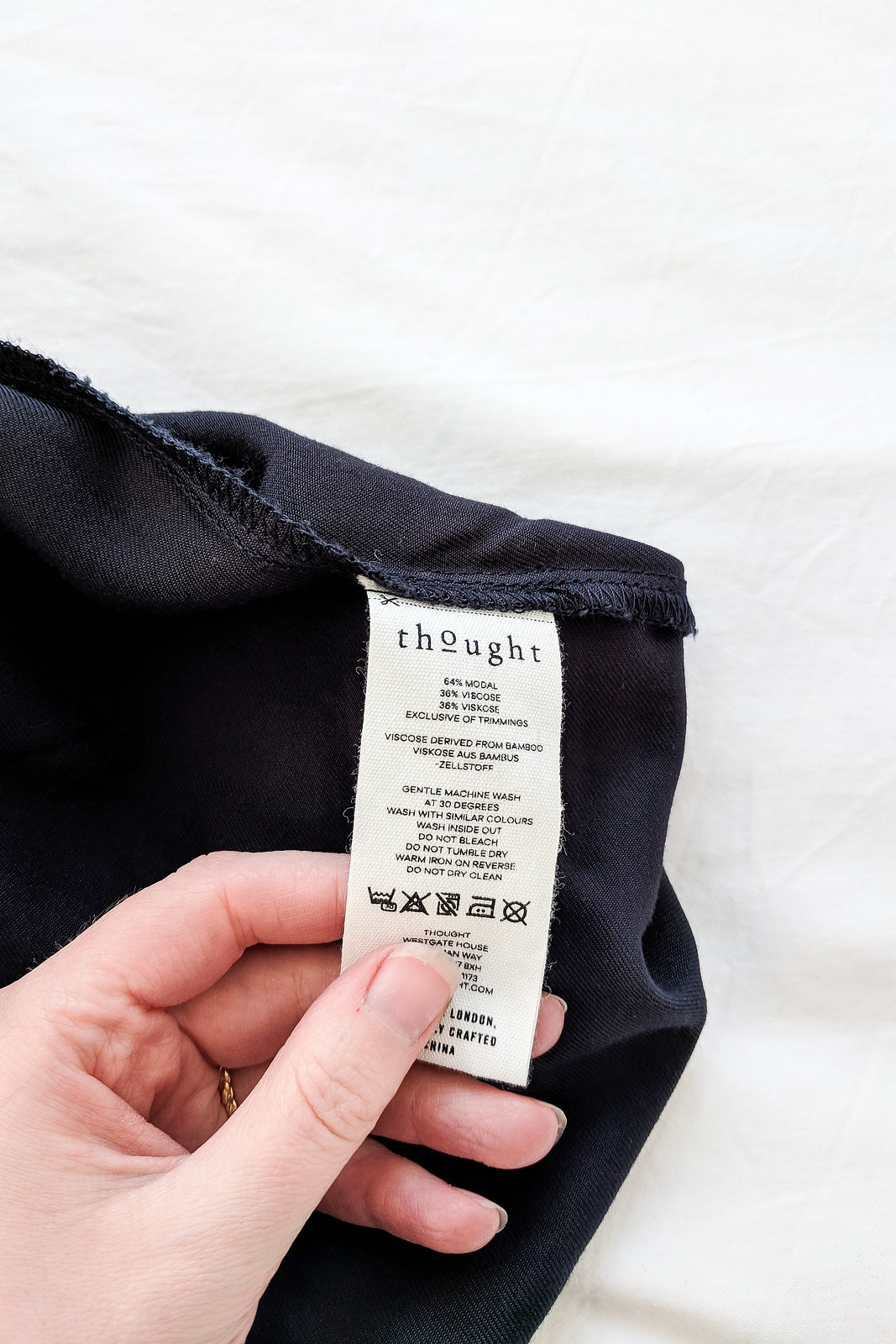
After purchasing thrifted items that required a few basic tweaks to make them work; I've been focusing on giving the rest of my wardrobe a little TLC. From missing buttons to worn fabric, investing the time in some wardrobe upkeep is a surefire way to make your clothes feel new again. I don't know about you but I'm always reluctant to wear something that isn't quite right and faded clothing makes me feel scruffy. These items get pushed to the side as the mere sight of them reminds me of all the things I know I need to fix but keep putting off. So this month I decided to tackle those problems head on and finally fix them.
For anyone who has an almost entirely black wardrobe (my hand is up), you'll know how tricky it can be to maintain the colour. Black clothing has a tendency to fade shockingly fast and becomes noticeably worn in appearance. I've tried all the tricks in the book to maintain my black clothing, nothing works; sooner or later they all fade.
Dyeing clothing back to their former glory is the most obvious answer but what isn't quite so obvious is the most environmentally-friendly option. After a lot of lip-biting and head-scratching, I went for the option I believe gets the balance right between achieving results and being kind to the planet. In case you want to explore other options, before I explain the pros and cons of the method I chose, these are some alternative ways to dye your clothes:
Methods For Dyeing Clothes
Natural Dyes. You can make your own dye using plant-based ingredients such as fruits, vegetables, and herbs. This method is only good for natural fabrics and the results are unpredictable. The process is rather long-winded and the dye isn't likely to last very long, however, it is environmentally-friendly.
Pre-Mixed Dye. Available for both hand and machine washing, these dyes are made mostly from synthetic ingredients. The dye job is effective and longer lasting with a more intense result. Since the dye will be entering the water system, it's important to choose the dye you use carefully.
Cold Water Dye. This process requires fiber reactive dye with salt added to help bind the dye to the fabric. This method requires constant agitation for an effective dyeing process. Results are much better for white clothing, whether you're dyeing them back to white or changing their colour.
Dye Bath. Using pre-mixed fabric dye like RIT or Dylon, this method involves dyeing clothing in a sink, bucket, or on the stove top. You'll often only be able to dye single items at a time or you'll risk an uneven dyeing process, which makes this process inconvenient and messy.
Machine Dye. This method involves throwing everything in the washing machine along with a pre-mixed dye. You'll be able to dye larger quantities of clothing and achieve better results with a more even finished result. It has the potential to be more water intensive than the dye bath or cold water method.

After reading up about all my options, I chose to use my washing machine to dye my clothes using Dylon Dye Pods. I thought it might be useful to explain my reasons and why this method, although not perfect, might be the best option after all.
Low Risk With Lasting Results. Pre-mixed dye, although made from synthetic ingredients, are low risk. They produce effective and long lasting results whereas natural dyes are unpredictable, producing uneven results that fade quicker; meaning the whole process has to be repeated. Dyeing clothing true black is difficult to do with natural dyes and would mostly require quite a few tries to achieve a good colour. This inevitably wastes more ingredients and more water to produce less than satisfactory results.
Convenient and Mess-Free. Pre-made dye is convenient, easy to use, and not as messy as hand dyeing. For someone who has never dyed clothing before (and lacks DIY skills), this method was foolproof for achieving great results. Using natural dye requires a level of trial, error, and a whole heap of patience when things don't turn out quite right. Pre-made dye means I could get the results I wanted first try.
Safe To Use. Dylon dyes have been tested for their environmental impact; the dye dilutes in the water to a safe level (for humans and animals) and can be dealt with effectively in the sewage system. It's not as eco-friendly as using natural dyes but it is a more effective method. Both pre-made and natural dyes are safe to use just be careful with sensitive skin.
Efficient and Effective. Using your washing machine to dye clothes is a water intensive process, there's not getting around that. However, it has significantly less impact than buying new clothes; paired with the effectiveness of pre-made dyes, I was satisfied that this was the most efficient and effective method of achieving a long lasting result.
Recyclable (maybe). One glaring negative when using pre-made dyes is the packaging. Dylon Dye Pods are plastic pots in a plastic wrapper, both of which can potentially be recycled depending on your local services. I don't mind a little bit of plastic to refresh my clothing and make them wearable again if it means I avoid replacing them, you might feel differently and want to try your hand at natural dye instead.

How To Dye Clothes
I read a lot of negative reviews of machine fabric dye, which made me nervous to try it. Many reviews claimed the clothes didn't dye properly or weren't vibrant, and there were a few that said the dye pods didn't work at all. Fortunately my experience was excellent; the clothes I dyed came out fully dyed intense black and I was very happy with the results. The problem lies in not reading the instructions in full and trying to dye synthetic fabrics. This is how to dye your clothes successfully:
Read the labels. Dylon Dye Pods will only fully dye cotton, linen, and viscose or partially dye semi-synethic fabrics such as modal; it will not dye fully synthetic materials like polyester! Always check the labels because what you think is a natural fabric might not be. I dyed cotton, linen, and viscose and all three achieved fantastic results. If you have synthetic fabrics you want to dye, you'll need dye specifically for synthetics.
Weigh your clothes. If you're dyeing clothes a different colour, make sure not to put more than 600g of clothes per pod in the washing machine; this worked out at two items for me. If you're dyeing faded clothes back to their original colour you can get away with adding a couple more items to the load, perhaps 3-5 so long as they are lightweight pieces like t-shirts. I've yet to test this theory out though!
Dampen clothes. Get your clothes damp before putting them in the washing machine. I put them under the shower and lightly wrung out the clothes so they weren't sopping wet. Don't fold the clothes up just place them in the drum.
Add pod. Take off the wrapper and peel off the lid, placing the pod on top of the clothes in the drum. The instructions tell you to wear gloves for this part and if I had some I would have worn them as I ended up with a little bit of dye on my hands. It easily washed off but if you have sensitive skin it might be best to protect you hands first.
Wash at 40. Use a basic cotton cycle (avoiding any pre-wash) at 40C without any detergent. After the first wash is complete, add laundry detergent and wash the clothes again on the same 40C cycle.
Dry the clothes. Remove the clothes and hang them to dry; don't place them over a radiator. I hung mine on a clothing rail in a sunny spot. The colour might change slightly when it's dry from how it looked when it was wet; I noticed there was a slight difference in shade between the linen, cotton, and viscose I dyed, which is to be expected.
Final wash. Once you're finished dyeing your clothes you need to ensure the washing machine is cleared of any dye residue. Put on a final wash to clear out the machine; I used it as an opportunity to run the thorough drum clean setting. If you have more clothing to dye, skip this step and go ahead with repeating the dyeing process. To reduce water wastage, I threw in any black items that needed washing for the final wash.
